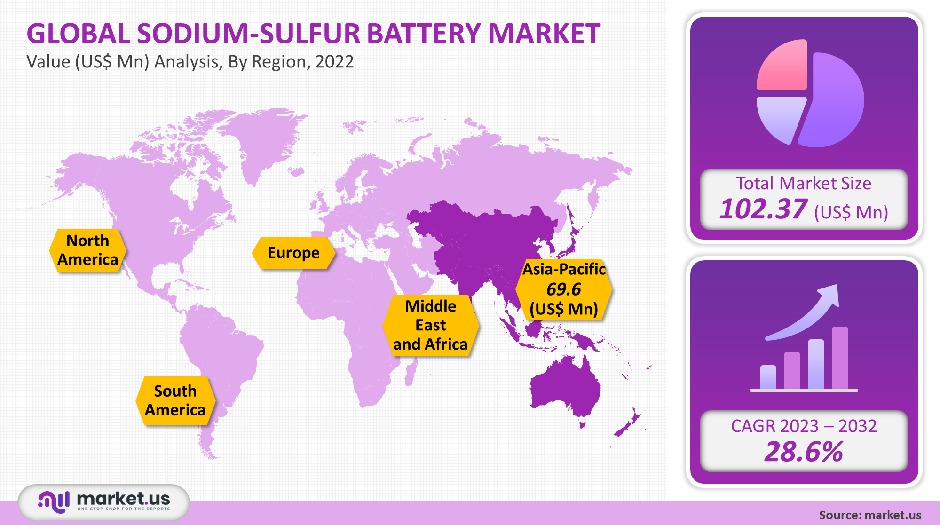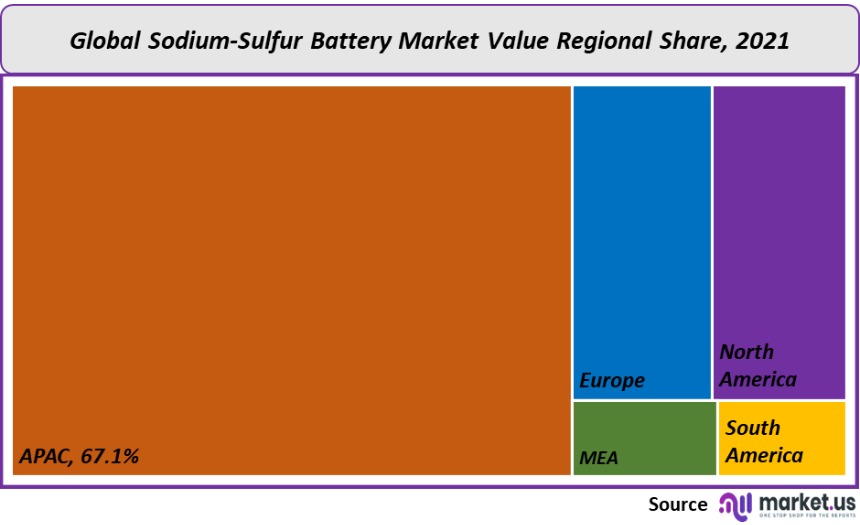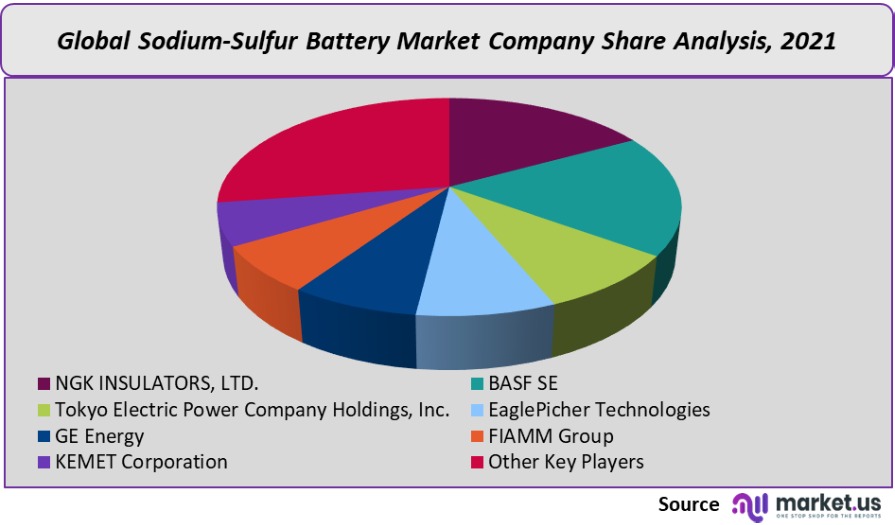Global Sodium-Sulfur Battery Market By Product (Private Portable and Industrial), By Application (Ancillary Services, Load Leveling, Renewable Energy Stabilization and Other Applications), By Region and Companies - Industry Segment Outlook, Market Assessment, Competition Scenario, Trends and Forecast 2022-2032
- Published date: Nov 2021
- Report ID: 16595
- Number of Pages: 277
- Format:
- keyboard_arrow_up
Sodium-Sulfur Battery Market Overview:
In 2021, the global sodium battery market was worth USD 102.37 million. The compound annual growth rate, for 2023-2032 is 28.6%.
The market is expected to grow in the future due to augmenting demand for power and storage using NAS, and battery technology. The smaller size of sodium-sulfur batteries makes them more suitable for areas with limited energy storage options.
As the power is not required to be exchanged right after generation, sodium-sulfur batteries can defer transmission up-gradation. The power can also easily be discharged at will. Also, the sodium-sulfur battery is used to maintain an urgent power supply and supply power for industrial and off-grid customers. The availability of alternate battery technologies like Lead-Acid batteries has resulted in a low adoption rate.
Global Sodium-Sulfur Battery Market Scope:
Product Analysis
The market is divided into two segments based on product: industrial and private portable. The majority of 2021’s total revenue was accounted for by the industrial product segments. This is due in part to the rising demand for sodium-sulfur batteries for grid storage and industrial applications. The increasing demand for sodium-sulfur batteries in industrial areas will lead to an increase in power backup and storage.
From 2023 to 2032 the private portable product sector is estimated to grow at 28.3%. NAS batteries can be adopted in portable devices at a rapid pace due to their low maintenance and high energy densities. This market segment is expected to grow because of high consumer electronics demand.

Application Analysis
A market segment is defined by the type of service: renewable energy stabilization, ancillary or load leveling, and others. The ancillary services application segment had a 32.0% share in 2021, the highest ever. The CAGR for ancillary services is estimated to be 30.6% between 2023-2032.
The ancillary services are required for the safe transmission and delivery of energy to grid areas. The fastest-growing segment in the forecast is the load-leveling application segment.
The market for renewable energy stability will continue to grow in the years ahead. Sodium sulfur batteries can be used to store energy for renewable energy generation. They are used primarily in wind farms and solar energy. The battery storage systems are able to accelerate energy consumption and reduce carbon emissions. The battery storage system can provide stability services to different mini-grids. It also facilitates an increase in variable renewable energy sources of power within such grid areas.
Key Market Segments:
By Product
- Private Portable
- Industrial
By Application
- Ancillary Services
- Load Leveling
- Renewable Energy Stabilization
- Other Applications
Market Dynamics:
The U.S. was valued at USD 4 million in 2021. The U.S. government supports the renewable industry and has increased demand for Battery Energy Storage Systems. Industry statistics will rise across the country by encouraging growth in the industrial sector, as well as energy to maintain grid stability with the integration of renewable sources of power.
NAS battery batteries face more moisture risk than other types. Therefore, regular servicing of the batteries and individual cell inspection is essential in order to maintain a long-lasting battery. There are many factors that limit the growth of the global market, including periodic inspection and maintenance and sealing costs. Also, installation in inaccessible areas and regulations on distributed electricity storage (DES).
Unexpected outbursts of the novel coronavirus have severely affected the global economic system. The widespread disruption of supply chains and the lack of human resources has resulted in delays to many projects including energy storage batteries as well as renewable integration. These factors have negatively impacted market growth.
Regional Analysis
The Asia Pacific held the greatest revenue share, 67.1%, in 2021. The region is expected to see substantial growth over the next period. As the Asia Pacific region grows in its investment in power generation, and rural electrification, there will be greater demand for storage batteries.
Japan is the leading country in sodium-sulfur battery use, with more than 170MW installed capacity. The continued industrialization in major economies of the region has meant that there is a growing emphasis on reliable electricity generation and grid stability.
Sodium sulfur batteries are uniformly being used to provide ancillary and frequency-regulated services. The market growth will also be supported by increasing efforts to reduce our carbon footprint by developing renewable energy infrastructure.
Europe is set to see notable growth over the next decade due to the increasing demand for NAS batteries. Technological innovations in terms of cost-effectiveness as well as improved efficiency and product innovation are expected to drive regional market growth. The market is expected to grow due to strict emission regulations by the governments in advanced countries like the U.K. and U.S. as well as increasing focus on fuel efficiency.

Key Regions and Countries covered іn thе rероrt:
- North America
- US
- Canada
- Mexico
- Europe
- Germany
- UK
- France
- Italy
- Russia
- Spain
- Rest of Europe
- APAC
- China
- Japan
- South Korea
- India
- Rest of Asia-Pacific
- South America
- Brazil
- Argentina
- Rest of South America
- MEA
- GCC
- South Africa
- Israel
- Rest of MEA
Market Share & Key Players Analysis:
Due to the presence and size of major companies, there has been intense competition in the market for sodium-sulfur batteries. This market is mainly focused on business growth.
Market players are now focusing more on developing nations to meet the rising demand for NAS-battery batteries. To expand and consolidate their market share within the industry, market participants are also investing in product design. In 2019, NGK (Basf) announced an expansion of their existing partnership and a joint agreement (JDA), which will allow them to develop next-generation sodium-sulfur batteries. The major players in this sodium-sulfur battery market are

Маrkеt Кеу Рlауеrѕ:
- NGK INSULATORS, LTD.
- BASF SE
- Tokyo Electric Power Company Holdings, Inc.
- EaglePicher Technologies
- GE Energy
- FIAMM Group
- KEMET Corporation
- POSCO
- Sieyuan Electric Co., Ltd.
- Other Key Players
For the Sodium-Sulfur Battery Market research study, the following years have been considered to estimate the market size:
Attribute Report Details Historical Years
2016-2020
Base Year
2021
Estimated Year
2022
Short Term Projection Year
2028
Projected Year
2023
Long Term Projection Year
2032
Report Coverage
Competitive Landscape, Revenue analysis, Company Share Analysis, Manufacturers Analysis, Volume by Manufacturers, Key Segments, Key company analysis, Market Trends, Distribution Channel, Market Dynamics, COVID-19 Impact Analysis, strategy for existing players to grab maximum market share, and more.
Regional Scope
North America, Europe, Asia-Pacific, South America, Middle East & Africa
Country Scope
United States, Canada and Mexico, Germany, France, UK, Russia and Italy, China, Japan, Korea, India and Southeast Asia, Brazil, Argentina, Colombia etc.Saudi Arabia, UAE, Egypt, Nigeria and South Africa
Frequently Asked Questions (FAQ)
Q: What is the Sodium-Sulfur Battery Market size in 2021?A: The Sodium-Sulfur Battery Market size is US$ 102.37 million for 2021.
Q: What is the CAGR for the Sodium-Sulfur Battery market?A: The Sodium-Sulfur Battery Market is expected to grow at a CAGR of 28.6% during 2023-2032.
Q: What are the segments covered in the Sodium-Sulfur Battery Market report?A: Market.US has segmented the Global Sodium-Sulfur Battery Market Value (US$ Mn) Analysis by Region, 2022 market by geographic (North America, Europe, APAC, South America, and Middle East and Africa). By Application, market has been segmented into Ancillary Services, Load Leveling, Renewable Energy Stabilization and Other Applications. By Product, market has been further divided into Private Portable and Industrial.
Q: Who are the key players in the Sodium-Sulfur Battery market?A: NGK INSULATORS, LTD., BASF SE, Tokyo Electric Power Company Holdings, Inc., EaglePicher Technologies, GE Energy, FIAMM Group, KEMET Corporation, POSCO, and Other Key Players, are the key vendors in the Sodium-Sulfur Battery market
Q: Which region is more attractive for vendors in the Sodium-Sulfur Battery market?A: APAC accounted for the highest revenue share of 67.1% among the other regions. Therefore, the Sodium-Sulfur Battery Market in APAC is expected to garner significant business opportunities for the vendors during the forecast period.
Q: What are the key markets for Sodium-Sulfur Battery?A: Key markets for Sodium-Sulfur Battery are the UK, India, China, Argentina, Brazil, Uruguay & Others
Q: Which segment has the largest share in the Sodium-Sulfur Battery market?A: In the Sodium-Sulfur Battery market, vendors should focus on grabbing business opportunities from the ancillary services segment as it accounted for the largest market share in the base year.
![Sodium-Sulfur Battery Market Sodium-Sulfur Battery Market]() Sodium-Sulfur Battery MarketPublished date: Nov 2021add_shopping_cartBuy Now get_appDownload Sample
Sodium-Sulfur Battery MarketPublished date: Nov 2021add_shopping_cartBuy Now get_appDownload Sample - NGK INSULATORS, LTD.
- BASF SE
- Tokyo Electric Power Company Holdings, Inc.
- EaglePicher Technologies
- GE Energy
- FIAMM Group
- KEMET Corporation
- POSCO
- Sieyuan Electric Co., Ltd.
- Other Key Players
- settingsSettings
Our Clients
|
Single User
$5,999
$2,999
USD / per unit
save 50% |
Multi User
$7,999
$3,499
USD / per unit
save 55% |
Corporate User
$12,999
$4,499
USD / per unit
save 65% | |
|---|---|---|---|
| e-Access | |||
| Data Set (Excel) | |||
| Company Profile Library Access | |||
| Interactive Dashboard | |||
| Free Custumization | No | up to 10 hrs work | up to 30 hrs work |
| Accessibility | 1 User | 2-5 User | Unlimited |
| Analyst Support | up to 20 hrs | up to 40 hrs | up to 50 hrs |
| Benefit | Up to 20% off on next purchase | Up to 25% off on next purchase | Up to 30% off on next purchase |
| Buy Now ($ 2,999) | Buy Now ($ 3,499) | Buy Now ($ 4,499) |









